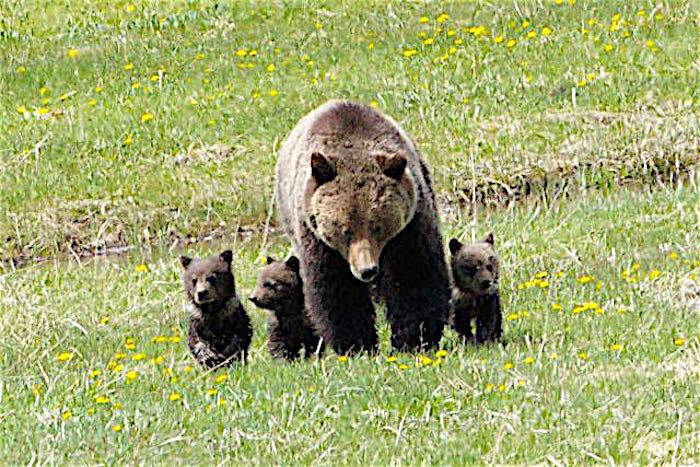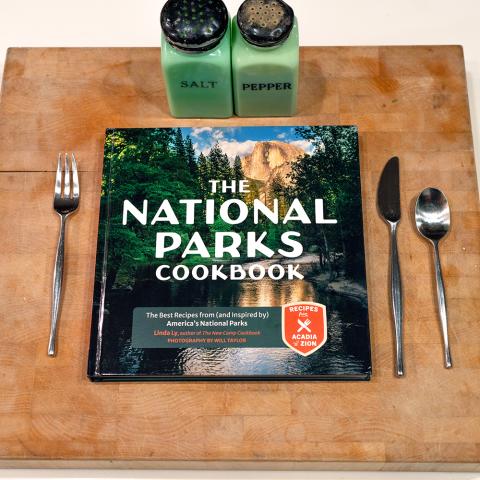
Park Service doesn't want a hunting free-for-all if grizzlies are delisted/Randy Bjerke
National Park Service officials are supportive of plans to remove grizzly bears from Endangered Species list protections, but with a number of caveats. Among them are requests that the delisting plan both limits the chance that wounded bears venture back into parks and reduces the likelihood that "well-known or transboundary bears" are killed by hunters.
Bears, of course, don't know when they might leave Yellowstone or Grand Teton national parks and wander into one of the surrounding national forests. But if the U.S. Fish and Wildlife Service succeeds with its plans to remove grizzly bears, aka Ol' Ephraim, aka Ursus arctos horribilis, from ESA protection, officials in Wyoming, Idaho, and Montana plan to be ready with hunting regulations for that day. And that could put any grizzly that leaves either of those parks in the crosshairs of a hunting rifle.
"The NPS continues to focus on supporting the delisting process while trying to ensure values of the NPS are considered in management strategies and actions. Grizzly bears are a premier wildlife attraction for visitors to Yellowstone, Grand Teton and John D. Rockefeller, Jr., Memorial Parkway; and those visitors bring tens of millions of dollars into the regional economy," wrote Sue Masica, (letter attached below) who oversees the Park Service's Intermountain Region, in the agency's official comments to the delisting proposal. "The bears contribute to the public's enjoyment and sense of pride in our conservation heritage."
To see that those values aren't overturned, the Park Service asks that "future grizzly bear harvests within the Greater Yellowstone Ecosystem be conducted in a manner that: I) respects the NPS mission; 2) protects regional economic benefits and the enjoyment of bear watching; 3) reduces the risks associated with wounded bears entering NPS units; and 4) limits the likelihood that well-known or transboundary bears will be harvested."
Along those lines, Regional Director Masica specifically asked that the Rockefeller parkway officially be recognized as one of the three park units that could be impacted by the delisting decision and that it, as with Yellowstone and Grand Teton, be off-limits to hunters.
Biologically, the Park Service has asked the Fish and Wildlife Service to perform an analysis into how hunting impacts might affect the potential for connectivity between the GYE grizzly populations and those in the Northern Continental Divide Ecosystem that includes Glacier National Park in northern Montana. Additionally, the agency requested that if the grizzly population in the GYE falls below 600 individuals that hunting be stopped.
While the Fish and Wildlife Service intends to complete the delisting process by year's end, it likely won't go smoothly. Wyoming officials maintain that the enabling legislation for the John D. Rockefeller, Jr., Memorial Parkway allows hunting there, and so grizzlies that wander into the parkway would be fair game.
“My understanding is they can’t change that," Brian Nesvik, Wyoming Game and Fish Department chief game warden, told WyoFile last week.
Just the same, he added, Wyoming didn't push for wolf hunting in the parkway when that species was delisted, and so it is too early to say whether the state would try to open the parkway to grizzly hunts.
Lawsuits also could be in the mix. Like Yellowstone's wolves and bison, the park's grizzlies, and those in neighboring Grand Teton, are iconic and widely admired. The prospect of them ending up as trophy animals isn't easily accepted among those groups. That was evident in the uproar spurred by the recent news that Scarface, an iconic Yellowstone grizzly, had been killed by a hunter just north of the park's borders.
Too, there's the question some groups have voiced about whether the GYE grizzlies can survive hunting seasons.
"The historic comeback of the Yellowstone grizzly bear population is truly a remarkable achievement. But the current proposal threatens progress made to date. The Service is rushing to delist the grizzly bear before it knows how the Northern Rockies states and other federal agencies plan to manage it. It is unacceptable to proceed with delisting when the state and federal plans governing how this population will be managed are incomplete and therefore, unenforceable," said Jamie Rappaport Clark, president and CEO of Defenders of Wildlife and a former FWS director.
“Further, the Service’s current proposal doesn’t provide grizzlies with enough protections to ensure their long-term recovery. We can’t afford to be careless with this species. There is no need to rush this process, but that’s exactly what the Service appears to be doing.”




 Support Essential Coverage of Essential Places
Support Essential Coverage of Essential Places







Comments
1.2 million on Fed lands (fed.us)
18 mil AUMs with typical usage 3-6 months equals 4 million (BLM report)
5 million divided by 30 million total cattle = 16+% (beefusa)
And that doesn't include grazing on NPS land
Try again, Esteemed Comrade. Dairy cows must be included in the total because most of them become beef at some point in time. Calves must also be included. Leaving those out skews the numbers.
From Beef USA: All cattle and calves Jan 1, 2016, 92.0 million head
5 million federal animals divided by 92 million total cattle = 5.4%
Then they would be counted as part of the beef cows. Dairy cows are milked everyday, they aren't left to roam on federal lands. But as I said before, whether the number is 3%, 5.4%, 10% or 16%, it is a significant number that has an impact on beef prices and has beneficial effects on the land.
Just an FYI, according to the BLM:
" Grazing use on public lands has declined from 18.2 million AUMs in 1954 to 8.3 million AUMs in 2014 (a 54 percent decrease). "
Using the above 'formula,' it calculates out to 1.78 million, not 4 million.
Additionally, that number is not all cattle - it includes sheep, goats, horses, and burros. But, to make it easy, let's say 1.75 million cattle.
Using the first formula numbers with the correct number: 1.75/30 million, shows 5.8%.
Using the second formula: 1.75/92 million, shows 2%
Just so we have our numbers correct...
Dahkota - don't forget the the fed lands cattle and the divisor is beef cattle not all cattle.
"Beneficial effects on the land???????"
And thanks, dahkota.
Now perhaps it's time to let other readers decide which information is correct and which is not.
Why does NPS support delisting at all? It is not just about protecting bears that people pay to see. This should be about insuring the population is viable long term. Right now, the Yellowstone population is not connected to any other grizzly population. Further, the Yellowstone grizzlies have lost several key food sources in the last two decades - due to climate change and invasive species. Finally, most Americans (68%, including 50% of hunters) simply do not want grizzly bears to be hunted for trophies. It is against the new American ethos to kill an iconic wild animal to become a rug or to be hung on someone's wall.
Cattle should not be grazing in national forrest or BLM public lands.